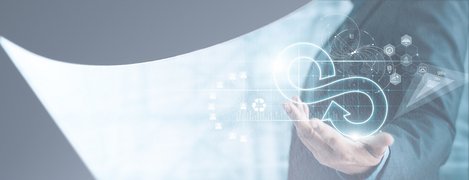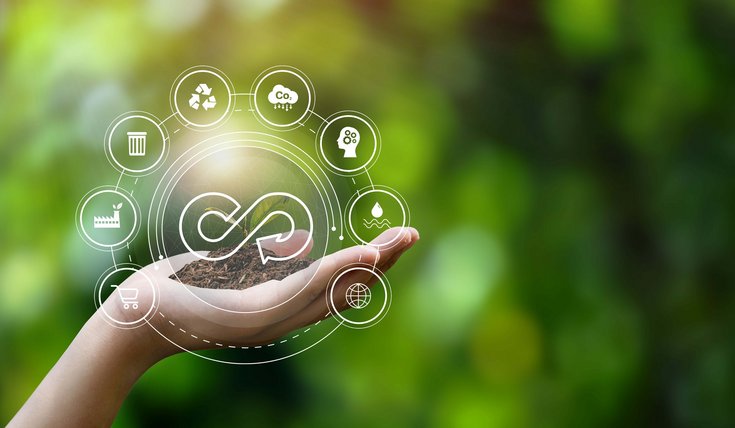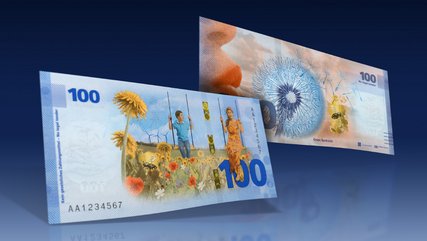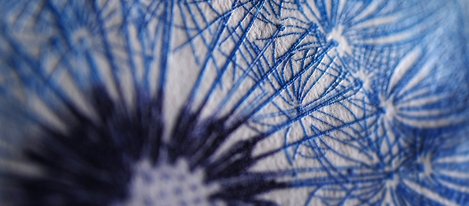

On the road to circularity: the steps we take (and you could, too)
Fundamental economic insights show that the planet can no longer support our linear production path. The circular economy, therefore, represents a great opportunity for all of us, but also a challenge: it proposes a new, radically different way of thinking about economic activity – a way of thinking that will also secure economic prosperity in the long term. What this means for a future-proof and sustainable cash cycle.
At first, it sounds as plausible as simple: by mimicking nature, the circular economy enables us to (re)organize our economy in such a way that nothing is wasted, and value creation is maximized. Or to be even more specific and detailed: a circular economy means using resources efficiently and prioritizing renewable inputs, maximizing a product’s usage and lifetime to extract the maximum value, and recovering and reusing by-products and waste to make new materials or products.
However, a closer look also shows that the challenge of effective management always hovers above everything else: “Circularity is about responsibly managing the flow of renewable resources and the stock of finite materials by creating closed material and energy loops in which all materials are reintroduced into the system in a continuous cycle”, says Alexandra Geiger, Sustainability Engineer Banknote Solutions Division at Giesecke+Devrient.
A ”closing the loop” that can’t and shouldn’t be done alone: as more and more governments, central banks, commercial banks, cash-in-transit companys, and businesses looking for new solutions to make the cash cycle more sustainable that loop has to acknowledge, respect, and focus on multiple players and their roles.
Why a circular economy might become the new normal

Collaboration models that establish the best overall solutions for maximizing sustainability and efficiency across the borders of different players are key. “But, critically, also ones that ensure all participants attain advantages by committing to new standards”, explains Bernd Kümmerle, Managing Director of the Banknote Solutions Division at G+D Currency Technology. “If all cash cycle players work together on an overall solution for their part of the cycle, finally the cost of cash will be reduced, and the players can reap the benefits of standardization”.
An example that is as obvious as it is simple is plastic and its negative impact on the environment: plastic may be durable, but that means that its waste can remain in our environment for centuries if it is not disposed of properly. And while plastics easily break down into fragments through wear and tear, their polymer chains only deteriorate into other smaller components at very high temperatures.
“The world still largely operates on the ‘linear economy’ model – sometimes known as ‘take-make-discard’– where raw materials are used to manufacture products, only to be disposed of at the end of their short lifetimes", the initiative “Alliance To End Plastic Waste” states. But “transitioning to a more sustainable model is not rocket science if we can remember the 3 Rs: Reduce, Reuse, Recycle – in that specific order of priority!”
For G+D “from waste to worth” means consequently focusing on measures promoting the circular economy while bringing together different stakeholders. Says Kümmerle: “There is no silver bullet solution, it’s not about swapping from one single-use lifestyle to another, but instead about changing our behavior to balance convenience and sustainability". What G+D does is pave the road to circularity by “linking the value chain of creation directly to the value chain of distribution, circulation, and end-of-life”.
The road to circularity never ends
The starting signal is G+Ds Green Banknote, “which takes the product 'banknote' to a higher level by working with new types of locally grown fibers, certified organic cotton, and recycled materials, by optimizing the use of innovative products, or by using environmentally friendly printing inks", says Clemens Berger, Chairman of the Management Board of the substrate and foil manufacturer Louisenthal. It continues with a clear focus on efficiency and the use of less energy and waste by automation digitalization. And it might lead to AI-based cash demand forecasting for fewer cash transports or local End-of-Life solutions beyond traditional Banknote Destruction Systems.
"That's "closing the loop" in a circular economy, the main step towards a green currency industry: maintaining the value of raw materials, components, and products, using renewable energy sources, and acting systemically", Berger adds. "But sure, we are at the same time well aware that many companies might understand the concept of circularity but struggle to apply it to their businesses".

Think, rethink, and rethink again
Fully integrated circular business models extend value creation beyond the scope of short-term financial value, the PwC-study "The Road To Circularity" says. "They focus on value creation in a larger sense, taking customer, environmental and societal value into account." This means formulating a circular strategy and rethinking business models and changing corporate strategy; understanding that it is a true transformation process – internally as well as in collaboration with customers, suppliers, and other stakeholders; and finally monitoring the steps towards circularity through adequate management and reporting processes.
“We begin with our Green Banknote and we’ll end with a closer, more successful, and sustainable collaboration”, Bernd Kümmerle concludes. Be it circular sourcing, resource efficiency, or usage optimization, "the road to circularity never ends, it leads to a "product as a service"-thinking, and within the green cash cycle this means for us to think, act, and trust each other in the most effective way to explore answers and find new sources of value”.
NEWS
Fresh new member of "Team Green": Green LongLife™

A more sustainable cash cycle is the goal of every central bank – and as a leading provider of banknotes based on natural renewable fibres, we are constantly working to improve all our products and make them even more sustainable.
With Green LongLifeTM, we have succeeded in further increasing the amount of renewable raw materials in a particularly durable banknote substrate. At the same time, we reduced the content of mineral oil-based materials such as plastic to an absolute minimum and opted for mineral oil-free inks. With Green LongLife, we have retained the well-known strengths –and decisively improved sustainability once again.
Alternative fibres such as organic cotton or Cotton made in Africa (CmiA) can be selected for substrate production. The Galaxy® security thread and RollingStar® LEAD Mix film now use 70% recycled polyester, and the biobased carbon content is > 85%.
Green LongLife delivers unmatched security from within, offering the possibility of being protected with the most advanced security features.
Advantages of Green LongLife:
- High biobased carbon content by using natural fibres
- Pre-coating based on natural raw materials
- Mineral oil-free inks
- Reduced carbon emissions with the use of certified organic cotton
- High durability achieving up to 2x lifetime compared to standard banknotes
- Unmatched security from within utilising substrate-embedded L1, L2 and L3 Features
- Numerous possibilities for repurposing – from Banknote Fibre Extraction to composting and many more

Further reading
The Green Banknote Initiative
As a leading company in the industry, we take sustainability seriously. Based on a study that took a close look at banknote substrates, we have broadened our focus on the subject of sustainable banknotes.
Green LongLifeTM banknote paper
Durable pre-coated substrates make banknotes more sustainable by reducing the need for frequent reprints – and support central banks in operating more efficiently. With Green LongLife, we have succeeded in preserving the well-known qualities of LongLife while significantly enhancing sustainability.